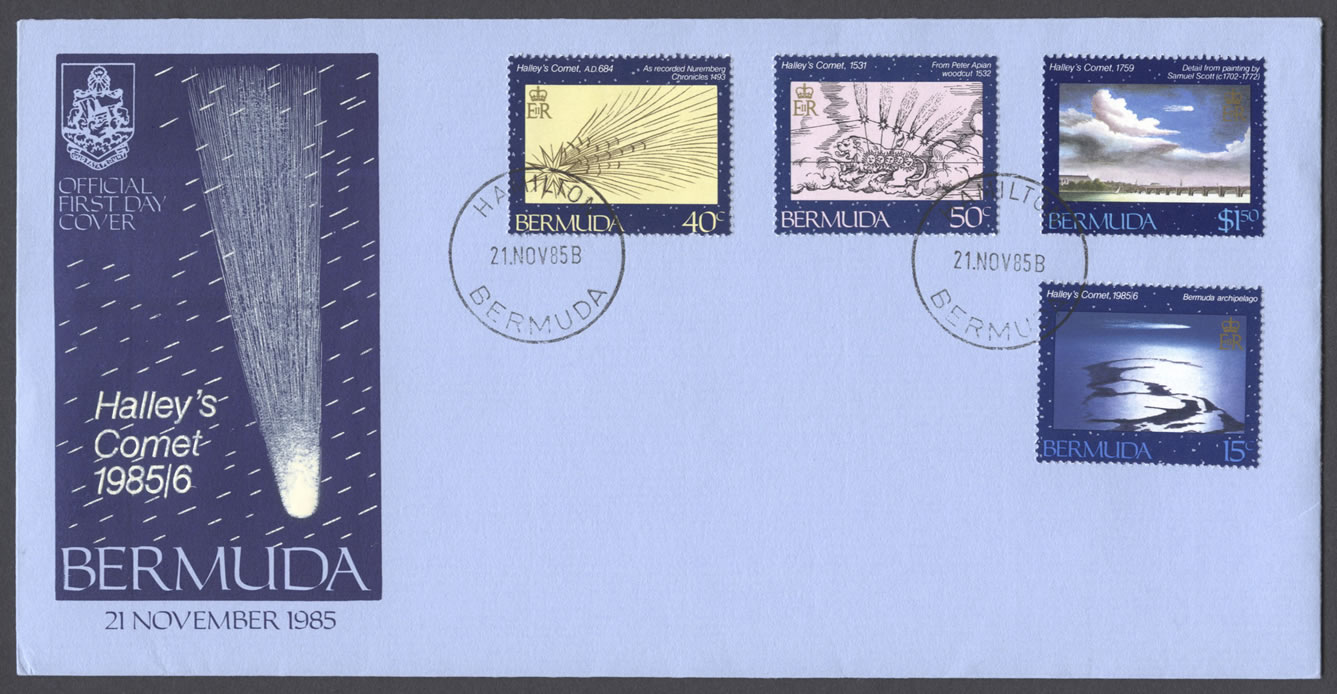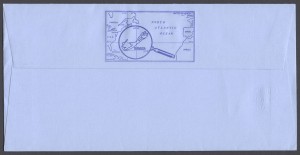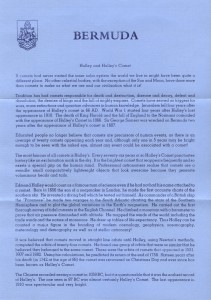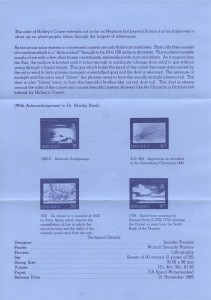Your basket is currently empty!

1985 Halley’s Comet 1985/6
Commemorating Halley’s Comet
Date: 21st November 1985
Stamps: BERMUDA 15c Halley’s Comet, 1985/6 Bermuda Archipelago; 40c Halley’s Comet, A.D.684 As recorded Nuremberg Chronicles 1493; 50c Halley’s Comet, 1531 From Peter Apian woodcut 1532; $1.50 Halley’s Comet, 1759 Detail from painting by Samuel Scott (c 1702-1772)
Official First Day Cover
Cachet: OFFICIAL FIRST DAY COVER Halley’s Comet BERMUDA 21 NOVEMBER 1985
CDS: 21.NOV85B HAMILTON BERMUDA
BERMUDA
Halley and Halley’s Comet
If comets had never visited the inner solar system the world we live in might have been quite a different place. No other celestial bodies, with the exception of the Sun and Moon, have done more than comets to make us what we are and our civilization what it is!
Tradition has had comets responsible for death and destruction, disease and decay, defeat and dissolution, the demise of kings and fall of mighty empires. Comets have served as triggers for wars, mass extinctions and quantum advances in human knowledge. Jerusalem fell four years after the appearance of Halley’s comet in 66 AD. World War 1 started four years after Halley’s last appearance in 1910. The death of King Harold and the fall of England to the Normans coincided with the appearance of Halley’s Comet in 1066. Sir George Somers was wrecked on Bermuda two years after the appearance of Halley’s comet in 1607.
Educated people no longer believe that comets are precursors of human events, as there is an average of twenty comets appearing each year and, although only one in 5 years may be bright enough to be seen with the naked eye, almost any event could be associated with a comet!
The most famous of all comets is Halley’s. Every seventy-six years or so Halley’s Comet punctuates history like an exclamation mark in the sky. It is the brightest comet that reappears frequently and so exerts a special grip on the human mind. Professional astronomers realize that comets are a swindle: small comparatively lightweight objects that look awesome because they generate voluminous heads and tails.
Edmond Halley would count as a famous man of science even if he had not had his name attached to a comet. Born in 1656 the son of a soapmaker in London, he made the first accurate charts of the southern sky. He invented a diving bell which he tested out himself. As commander of a British ship the “Paramore” he made two voyages to the South Atlantic charting the stars of the Southern Hemisphere and to plot the global variations in the Earth’s magnetism. He carried out the first thorough survey of tidal currents in the English Channel. He climbed a mountain with a barometer to prove that air pressure diminished with altitude. He mapped the winds of the world including the trade winds and the nature of monsoons. He drew up tables of life expectancy. Thus Halley can be counted a major figure in the founding of modem cosmology, geophysics, oceanography, meteorology and demography as well as of stellar astronomy!
It was believed that comets moved in straight line orbits until Halley, using Newton’s methods, computed the orbits of twenty-four comets. He found one group of orbits that were so similar that he believed they belonged to the same comet. These were the orbits of comets that appeared in 1531, 1607 and 1682. Using his calculations, he predicted its return at the end of 1758. Sixteen years after his death (in 1742 at the age of 86) the comet was recovered on Christmas Day and ever since has been known as Halley’s Comet.
The Chinese recorded seeing a comet in 1059 BC, but it is questionable that it was the earliest record of Halley’s. The one seen in 87 BC was almost certainly Halley’s Comet. The last appearance in 1910 was spectacular and very bright.
The orbit of Halley’s Comet extends out as far as Neptune but beyond Saturn it is too faint even to show up on photographs taken through the largest of telescopes.
As far as our solar system is concerned comets are only third-rate members. Basically they consist of a nucleus which is a “dirty iceball” thought to be 10 to 100 miles in diameter. This nucleus consists mostly of ice with a few other frozen constituents, embedded with dust and debris. As it approaches the Sun, the surface is heated until it is hot enough to sublimate (change from solid to gas without going through a liquid stage). This gas which forms the head of the comet becomes dissociated by the solar wind to form plasma (ionized or electrified gas) and the dust is released. The pressure of sunlight and the solar wind “blows” the plasma away to form the usually straight plasma tail. The dust is also “blown”away to form the beautiful feather-like curved dust tail. This dust is strewn around the orbit of the comet and causes beautiful meteor showers like the Orionids in October left behind by Halley’s Comet.
(With Acknowledgement to Dr. Morley Nash)
1985/6 – Bermuda Archipelago
A.D. 684 – Apparition as recorded in the Nuremberg Chronicles 1493.
1759 – Detail from painting by Samuel Scott (C 1702-1772) showing the Comet as seen from the South Bank of the Thames.
1531 – As shown in a woodcut of 1532 by Peter Apian which depicts the constellation of Leo in which the sun is moving and the tail/s of the comet/s point away from the sun.
Technical Details
Designer: Jennifer Toombs
Printer: Walsall Security Printers
Process: Lithography
Set: Sheets of SO stamps (2 panes of 25)
Stamp Size: 30.56 x 38 mm
Values: 15c, 40c, 50c, $1.50
Paper: CA Spiral Watermarked
Release Date: 21 November 1985
by
Tags:



Leave a Reply
You must be logged in to post a comment.